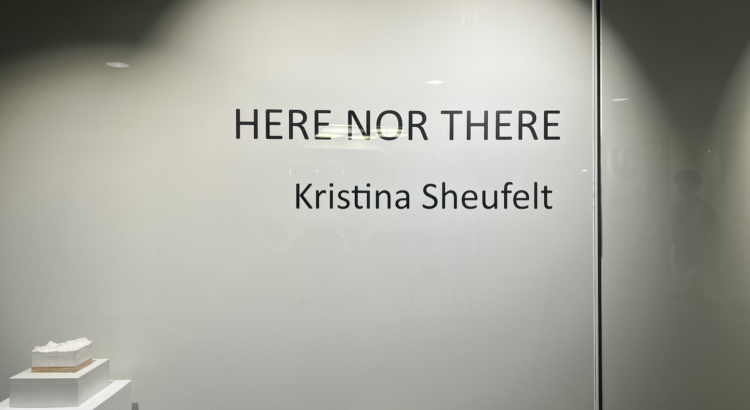Kristina Sheufelt’s Here Nor There effortlessly took me from place to place, conjuring up wilderness’ role in my own life, while simultaneously taking me into hers.
A Wind from Noplace Prototype I combined light-toned wood, metal, grass, and vials to create a “two-second line of data recording the artist’s heart rate in a meadow”. Although I didn’t understand the piece upon merely looking at it, reading that description produced an image of the artist laying alone in a meadow, grass hiding them from view, tickling the edges of their vision. I’d imagine their heartbeat at rest, slow-breathing. It felt like in a way, I knew her, distantly. I thought it was really creative how the artist combined nature with machinery. And yet, I didn’t really understand the piece itself. Were the blades of grass real, or fake? Was it wrong to take a living piece of the earth for our own creation? And why was one vial spaced out from the others? Perhaps the beat stuttering due to a bug in the grass? A plane whisking by overhead, the split-second alarm of engines and vehicles and being seen again?
I really enjoyed the intimacy of All I Have Left of the Mountains. Made of soil engraved with an excerpt from a journal entry following “a failed attempt to hike 500 miles of the Pacific Crest Trail,” again, I felt like Sheufelt was offering us a little window into her world. The mud was dried up, yet felt so visceral, contradicting the fading, fleeting words carved into the piece, oh so personal. Just hearing the word PCT stirs something in my heart, pumping extra blood and life into my veins. My first time backpacking – learning how to live out of a pack, in bare, desolate wilderness, traversing up and down mountains on my own two feet – crosscut that 2,650 mile trail. And I deeply relate – to the relief of going home, but also the ache of wanting to take the hills with you, of wanting to stay there forever.
Mask III reminded me of something you’d see in the Upside Down in Stranger Things. The eery, gray lifelessness, the material looking like it could shrivel away at a brush of touch, from half-dead wildlife to ashy dust. Even the dried glue between each milkweed pod looked from the slimy, rotting material of the other Hawkins.
Six attempts to remember Tinker Creek was probably my favorite. Smooth at certain angles and first look, each sculpture gets more geometric, depthy, and dynamic when you shift perspective, and move your head around the piece. This gives a sense that it’s not just a replica, nor a still scenery. I loved the pinkish-brown range, with all its glitter specked through the clay, reminding me of identifying quartz in countless rocks during my own summer, in the month I spent studying Geology at Camp Davis.
Surrogate is a wooden replica of the artist’s hand, carved in a way that makes you feel like the artist’s hand was just near, whittling away, just moments ago. As it stood suspended in the air, I noticed how it seemed to swing a little from left to right, and couldn’t tell if it was in my head or really doing a back-and-forth, but either way, it made it feel more real.
44 Days in Soil captured a wall full of forty-four soil samples gathered daily during a backcountry hike alone through the Appalachian Mountains of Virginia. The way the terrain from each day looks truly unique to each spot, unlike any other baggie taped to its left or right, was pretty amazing. It’s exciting to think that even a day’s worth of walking will get you to different lands of the Appalachians, dirt catching up the sole of your boot, old and new grains mixing and grotting together, holding onto you. There is a sense that the viewer can’t fully capture the weight of all that time laid before them, each really from a different day of her life, like the small, same squares on a calendar on a wall.
The digital photo prints of Nest told such a story in a few images. A dent in the grass, a nude-hued body curled up in a ball, grass pillowing this person, hugging it in, those lines you only get after a really good nap, the slight give and redness to the skin. Laying in the lap of Mother Earth.
After taking my time to take in each picture, project, and piece, I slowly made my way out, as if leaving the mountains. Heading out of the peaceful wilderness. There was one take-home card left on the table, and just like the rest of this exhibition, it felt like it had been waiting for me.













